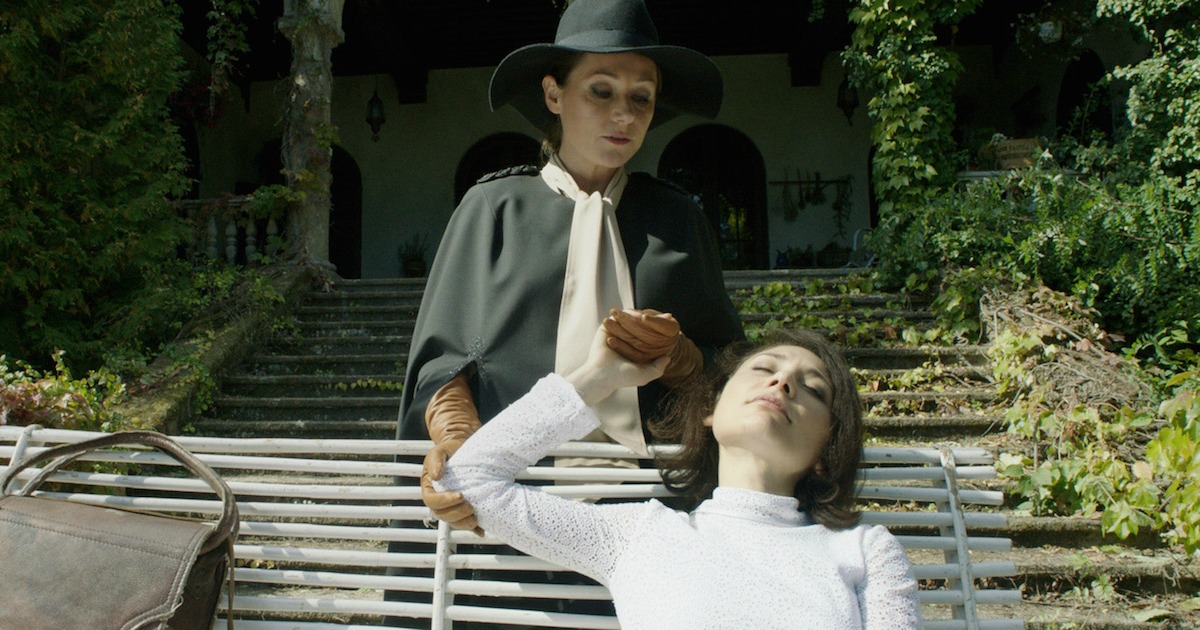
When the credits on a movie include a “human toilet consultant” then you know what follows isn’t going to be especially “normal.” Director Peter Strickland’s gorgeously strange and sensuous The Duke of Burgundy is a striking and densely layered portrayal of a sadomasochistic relationship between two women, which may sound off-putting, but it all boils down to one of the most unique love stories you’ll see onscreen this—or any—year.
Each day, in an unknown year and an unnamed European locale, two women follow a series of predetermined gestures, lines, and actions in a large gothic mansion. What we see is an intricate game of submission and domination, performance and roleplay, mostly involving Evelyn (the younger, soft-spoken maid played by Chiara D’Anna) being sternly reprimanded and subsequently “punished” by Cynthia (the older, middle-aged owner of the mansion played by Sidse Babett Knudsen). Sometimes these punishments result in Evelyn simply being told how worthless she is, but other times the punishments result in instances like Cynthia taking Evelyn behind closed doors off-camera into the bathroom to, um, well, let’s just say the tinkling of liquid heard isn’t coming from the faucet.
What makes The Duke of Burgundy resonate isn’t the assumption that the performative routine going on before us—which is astutely portrayed by the precise and meticulously controlled performances of D’Anna and Knudsen—is just a repetitive and kinky gimmick, but rather that the performative aspects are portrayed as an honest and essential part of the dynamic of this and every other romantic relationship as a whole. It’s like a BDSM version of Certified Copy, or a more vivid extension of Rainer Werner Fassbinder’s The Bitter Tears of Petra von Kant.
Filtered through the outwardly strange fetishistic behaviors of this otherwise tender and loving couple (maybe the farthest thing from what could be accepted as an orthodox relationship between two significant others) we’re meant to recognize in ourselves how we also behave. Despite all outwards appearances what we see is us, and we’re invited to address in ourselves who is submissive, who is dominant, and how much that really matters once the thrill is gone.
The feminine vacuum that Cynthia and Evelyn work within (there are no men in the entire movie and about 99% of it takes place inside the mansion walls) created by Strickland is molded even further when we realize that Evelyn is the one with all the power. She’s the puppetmaster pulling all the strings and conducting what goes on between the two, and her deepening desire for control is the crux of the entire film. For however essential Cynthia is to Evelyn, Evelyn’s enthusiasm to explore these scripted procedures even further becomes the thing that causes Cynthia to gradually back off and question their once inseparable bond. It’s a metamorphosis overtly implied by the characters being surrounded by countless specimens of moths and butterflies neatly tacked against the walls in cases throughout the house (both characters happen to be amateur lepidopterists).
Those unwilling to look a bit deeper may find The Duke of Burgundy languishes a bit too much in its slow-burn weirdness, yet those that give themselves over (in a sense we’re no longer voyeurs but participants in the movie) will be wrapped up in its undeniable and eerie eroticism. It’s probably the most downright sexy movies I’ve seen in a very long time, and there’s nary a naked body or overt sexual act throughout the entire runtime. This gets at why the movie is so effective. The Duke of Burgundy captures you, and emphasizes in its fetishism what is both seen and unseen. In any circumstance you won’t be able to look away.



![Bergman Island (The Criterion Collection) [Blu-ray]](https://criterioncast.com/wp-content/uploads/2022/11/bergman-island-the-criterion-collection-blu-ray-400x496.jpg)
![This Is Not a Burial, It’s a Resurrection (The Criterion Collection) [Blu-ray]](https://criterioncast.com/wp-content/uploads/2022/11/this-is-not-a-burial-its-a-resurrection-the-criterion-collection-blu-ray-400x496.jpg)
![Lars von Trier's Europe Trilogy (The Criterion Collection) [The Element of Crime/Epidemic/Europa] [Blu-ray]](https://criterioncast.com/wp-content/uploads/2022/11/lars-von-triers-europe-trilogy-the-criterion-collection-the-element-of-400x496.jpg)
![Imitation of Life (The Criterion Collection) [Blu-ray]](https://criterioncast.com/wp-content/uploads/2022/11/imitation-of-life-the-criterion-collection-blu-ray-400x496.jpg)
![The Adventures of Baron Munchausen (The Criterion Collection) [4K UHD]](https://criterioncast.com/wp-content/uploads/2022/11/the-adventures-of-baron-munchausen-the-criterion-collection-4k-uhd-400x496.jpg)
![Cooley High [Criterion Collection] [Blu-ray] [1975]](https://criterioncast.com/wp-content/uploads/2022/11/cooley-high-criterion-collection-blu-ray-1975-400x496.jpg)